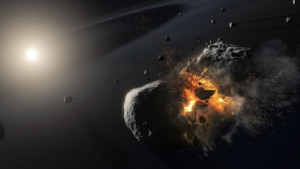Astronomers believe the suspected planet is a dust cloud caused by a cosmic collision.
Use this article with students in years 5, 7, and 10, studying Physical and Earth and Space sciences to demonstrate scientists’ changing understanding of space. It could be used to show how scientists gather data and make predictions to explain the solar system and beyond. It also shows that they aren’t always right the first time, and that the explanations are refined as more data is collected.
Word Count: 498
A planet thought missing in action probably never existed at all, according to new studies.
What the Hubble telescope saw, and astronomers believed to be an exoplanet in a nearby star system, was more likely an expanding cloud of very fine dust particles caused by two icy bodies smashing into each other.
Hubble caught the aftermath of that collision, suggest astronomers Andras Gaspar and George Rieke from the University of Arizona, US, in a paper in the journal Proceedings of the National Academy of Sciences.
And it was quite an event. “We do have evidence of such collisions in other systems, but none of this magnitude has been observed in our solar system,” says Rieke. “This is a blueprint of how planets destroy each other.”
The suspected exoplanet, named Fomalhaut b, was first described in 2008, based on data from 2004 and 2006. It was clearly visible in several years of Hubble observations, which revealed it was a moving dot.
Until then, evidence for exoplanets had mostly been inferred through indirect detection methods, such as subtle back-and-forth stellar wobbles and shadows from planets passing in front of their stars.
Questions remained, however. The object was bright in visible light, for example, which is unusual for an exoplanet, and it did not have a detectable infrared heat signature – also unusual as a planet should be warm enough to shine in the infrared, particularly a young one.
Things became even odder, Gaspar and Rieke say when their data analysis of Hubble images taken in 2014 showed the object had vanished. “Clearly, Fomalhaut b was doing things a bona fide planet should not be doing,” Gaspar says.
The authors believe the collision occurred not long before Hubble’s first observations were taken in 2004, and they estimate that the dust cloud has now expanded to a size larger than the orbit of Earth around the Sun.
What they find surprising is that the object is more likely on an escape path, rather than on an elliptical orbit, as expected for planets. This is based on adding later observations to the trajectory plots from earlier data.
“A recently created massive dust cloud, experiencing considerable radiative forces from the central star Fomalhaut, would be placed on such a trajectory,” Gaspar says.
“Our model is naturally able to explain all independent observable parameters of the system: its expansion rate, its fading and its trajectory.”
According to Gaspar’s and Rieke’s calculations, the Fomalhaut system, located about 25 light-years from Earth, may experience one of these events only every 200,000 years.
And they aren’t finished yet. They will be among those observing the Fomalhaut system during the new James Webb Space Telescope’s much-awaited first year of science operations.
A team will directly image its inner warm regions (the first time this has happened in a star system other than our own) seeking detailed information about the architecture of its elusive asteroid belt.
It will also search for bona fide planets orbiting Fomalhaut that might still await discovery.
Login or Sign up for FREE to download a copy of the full teacher resource







